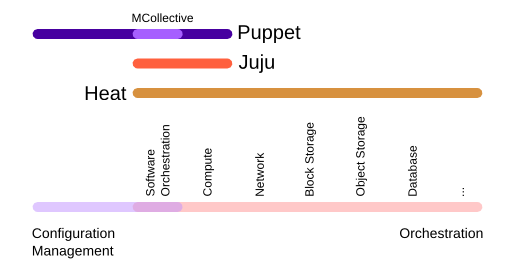At the last OpenStack Summit in Hong Kong, I had a chance meeting in the hallway with a prominent Open Source developer, who mentioned that he would only be interested in Heat once it could replace Puppet. I was slightly shocked by that, because it is the stated goal of the Heat team not to compete with configuration management tools—on the principle that a good cloud platform will not dictate which configuration management tool you use, and nor will a good configuration management tool dictate which cloud platform you use. Clearly some better communication of our aims is required.
There is actually one sense in which Heat could be seen to replace configuration management: the case where the configuration on a (virtual) machine never changes, and therefore requires no management. In an ideal world, cloud applications are horizontally scalable and completely stateless so, rather than painstakingly updating the configuration of a particular machine, you simply kill it and replace it with a new one that has the configuration you want. Preferably not in that order. However, I do not see this as a core part of the value that orchestration provides, although orchestration can certainly make the process easier. What enables this approach is the architecture of the application combined with the self-service, on-demand nature of an IaaS cloud.
Take a look at the example templates provided by the Heat project and you will find a lot of ways to spin up WordPress. WordPress makes for a great demo, because you can see the result of the process in a very tangible way. The downside is that it may be misleading people about what Heat is and how it adds value.
It would be easy to imagine that Heat is simply a service for provisioning servers and configuring the software on them, but that is actually the least-interesting part to me. There are many tools that will do that (Puppet, Juju, &c.); what they cannot do is to orchestrate the interactions among all of the OpenStack infrastructure in an application. That part is unique to Heat, and it is what allows you to treat your infrastructure configuration as code in the same way that configuration management allows you to treat your software configuration as code.

I am sometimes asked “Why should I use Heat instead of Puppet?” If you are asking that question then my answer is that you should probably use both. (In fact, Heat is actually a great way to deploy both the Puppet master and any servers under its control.) Heat allows you to manage the configuration of your virtual infrastructure over time, but you still need a strategy for managing the software configuration of your servers over time. It might be that you pre-build golden images and just discard a server when you want to update it, but equally you might want to use a traditional configuration management tool.
With the addition of the Software Deployments feature in the recent Icehouse (2014.1) release, Heat has moved into the software orchestration space. This makes it easier to define and combine software components in a modular way. It also creates a cleaner interface at which to inject parameters obtained from infrastructure components (e.g. the IP address of the database server you need to talk to). That notwithstanding, Heat remains agnostic about where that data goes, with a goal of supporting any configuration management system, including those that have yet to be invented and those that you rolled yourself.
If you would like to hear more about this with an antipodean accent, I will be speaking about it at the OpenStack Summit in Atlanta on Monday, in a talk with Steve Hardy entitled ‘Introduction to OpenStack Orchestration’. I plan to talk about why you should consider using Heat to deploy your applications, and Steve will show you how to get started.
Our colleague Steve Baker will be speaking (also with an antipodean accent) about ‘Application Software Configuration Using Heat’ on Tuesday.
